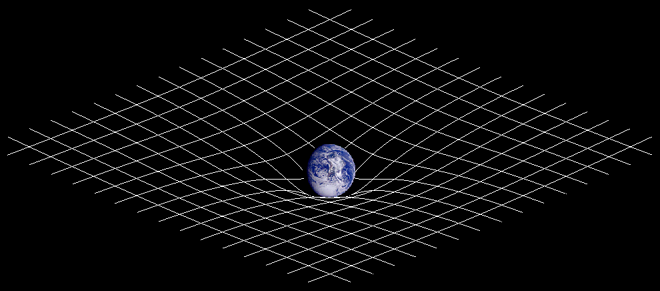I've seen many science popularisation documentaries and read few books (obviously not being scientist myself). I am able to process and understand basic ideas behind most of these. However for general relativity there is this one illustration, which is being used over and over (image from Wikipedia):

I always thought that general relativity gives another way how you can describe gravity. However for this illustration to work, there needs to be another force, pulling the object down (referring to a direction in the attached image). If I put two non-moving objects in the image, what force will pull them together?
So where is my understanding incorrect? Or is general relativity not about explaining gravity and just describes how heavy objects bends spacetime (in that case the analogy is being used not correctly in my opinion)?
UPDATE Thank you for the answers and comments. Namely the XKCD comics is a spot on. I understand that the analogy with bent sheet of fabric pretty bad, but it seems that it can be fixed if you don't bent the fabric, but just distort the drawn grid.
Would you be so kind and answer the second part of the question as well - whether general relativity is explaining gravitational force. To me it seems that it is not (bending of spacetime simply can not affect two non-moving objects). However most of the time it is being presented that it does.
Answer
You're quite correct that the metaphor is misleading, and indeed you'll find professional relativists tend to be rather scornful of it. There are a number of problems with it, of which the problem you mention is just one. For example the diagram implies only space is bent, while the bending is of spacetime so time is bent as well. The diagram also implies there is a third dimension out of the plane in which the bending occurs. Applied to our 4D spacetime this would mean there would have to be a fifth dimension for spacetime to bend in, but this isn't the case and the type of bending that occurs is called intrinsic curvature and needs no extra dimensions.
The problem is that GR is really, really unintuitive. If you want to know more than the hints suggested by the rubber sheet metaphor the only course is to roll up your sleeves and start learning the maths.
It would be nice if there were some intermediate course between the misleading but simple rubber sheet metaphor and the maths, but I don't know of anything. I think the problem is that you won't get anywhere without first understanding coordinate invariance and this is a really tough idea to understand. If you really want to learn more I'd start with special relativity as this contains the seeds of the ideas you'll need.
Response to comment:
In your edit you say bending of spacetime simply can not affect two non-moving objects. I'm guessing that you're thinking about objects rolling around on a curved surface as shown in the common metaphors for GR. The question is then why objects that aren't rolling around should experience a force.
The reason for this is that an apparantly stationary object is moving because it's moving in time. For the usual 3-D velocities we see around us we describe velocity as a 3-vector $\vec{v} = (v_x, v_y, v_z)$. But remember that spacetime is four dimensional, and the velocity for objects in relativity is a 4-vector called the 4-velocity that includes change in the time coordinate. The reason a stationary object experiences a force is that the time coordinate is curved just like the space coordinates. This brings me back to one of my criticisms of the rubber sheet analogy i.e. that it cannot show that the time coordinate is curved just like the spatial coordinates.
At the risk of getting repetitive, it's hard to explain why curvature in time causes the force without getting into the maths. The simplest explanation I've seen is in twistor59's answer to What is the weight equation through general relativity?. This shows, with the bare minimum of algebra, why a stationary object in a gravitational field experiences a force.
No comments:
Post a Comment